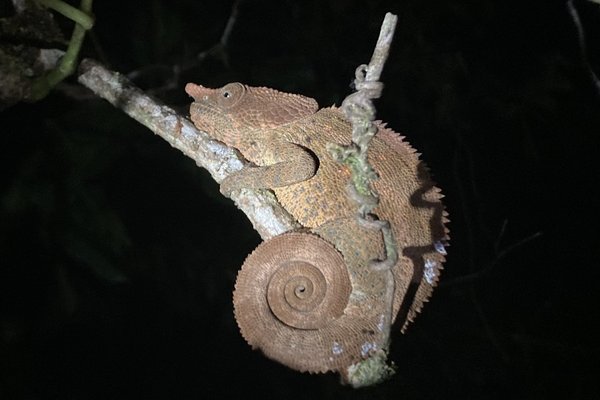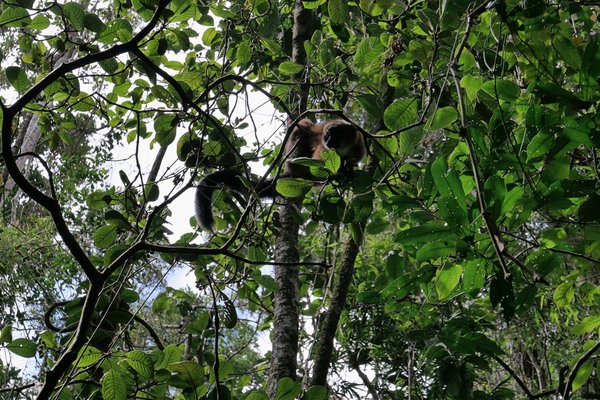Madagascar
Rainforests of the Atsinanana
The Rainforests of the Atsinanana are recognized for their very high biodiversity and high level of endemism in both plants and animals.
These are the remaining forests in which Madagascar's unique biodiversity survives. Most of the island's plant and animal life has evolved in isolation over the past 60 million years; up to 90% of the species found here are endemic. At least 25 species of the wholly endemic Malagasy primates, the lemurs, can be found in the forests. The rainforests are spread across six national parks on steep terrain in the east of the country.
Community Perspective: All reviewers so far have described their visits to Ranomafana NP, the most accessible of the included parks at about a day's drive from the capital. The typical itinerary consists of an evening/night visit (for the nocturnal species), followed by a forest walk the next day for the diurnal ones. Lemur and chameleon sightings will be abundant.
Site Info
Official Information
- Full Name
- Rainforests of the Atsinanana (ID: 1257)
- Country
- Madagascar
- Status
-
Inscribed 2007
Site history
History of Rainforests of the Atsinanana
- 2025: Removed from Danger list
- "major improvements, including the cessation of international illegal trade in rosewood and ebony"
- 2010: In Danger
- "The Committee noted that despite a decree outlawing the exploitation and export of rosewood and ebony, Madagascar continues to provide export permits for illegally logged timber." (Unesco)
- 2007: Revision
- Includes former TWHS Cap Masoala (1985) // Upon recommendation of IUCN, boundary changes have taken place before inscription. These include the removal of Mantadia and Midongy National Park from the nomination.
- 2007: Inscribed
- Inscribed
- Type
- Natural
- Criteria
- ix
- x
Links
- UNESCO
- whc.unesco.org
- Official
-
- parcs-madagascar.com — Parc National Andringitra
- parcs-madagascar.com — Parc National Marojejy
- parcs-madagascar.com — Parc National Masoala
All Links
UNESCO.org
- whc.unesco.org — whc.unesco.org/
Official Website
- parcs-madagascar.com — Parc National Andringitra
- parcs-madagascar.com — Parc National Marojejy
- parcs-madagascar.com — Parc National Masoala
- parcs-madagascar.com — Parc National Andohahela
- parcs-madagascar.com — Parc National Ranomafana
- parcs-madagascar.com — Parc National Zahamena
News Article
- Dec. 24, 2013 theguardian.com — Illegal logging of rosewood trees at Masoala NP
- April 22, 2012 africareview.com — Sapphire hunters descend on Zahamena rainforest
- July 31, 2010 whc.unesco.org — World Heritage Committee inscribes Rainforests of Atsinanana (Madagascar) on List of World Heritage in Danger
Community Information
- Community Category
- Wildlife habitat: Fauna
- Natural landscape: Forest
Travel Information
Recent Connections
-
Oceanic Dolphins
Masoala NP: IndoPacific Bottlenose and …
-
Former In Danger List sites
2010-2025
-
Perfect Inscriptions
2007
Connections of Rainforests of the Atsinanana
- Trivia
-
-
On Banknotes
The waterfall at the entrance of Ranomafana NP is on the 5000 Ariary note
-
- Ecology
-
-
Rainforests
"represent circa 20-25% of the total area of rainforests remaining in Madagascar" (AB ev) -
Notable examples of island gigantism
Hissing CockroachSee en.wikipedia.org
-
Eucalypts
Fire induced invasive plant species such as Eucalypts are a potential problem on the higher altitude western side of Ranomafana National Park (AB ev) -
Coral
coral reefs at Tambolo (UNEP-WCMC) -
Mangroves
7 species of mangrove (UNEP-WCMC) -
Whales
humpback and southern right whales at Masoala (UNEP-WCMC) -
Siraneans
dugong at Masoala (UNEP-WCMC) -
Turtles and tortoises
5 species of marine turtle (UNEP-WCMC)
-
Carnivorous plants
Nepenthes masoalensisSee en.wikipedia.org
-
Strepsirrhini
Various lemurs -
Cloud forest
Ranomafana NP: The range of altitudes in the park produces a variety of forest types, including lowland rainforest and cloud forest. (wiki) -
Oceanic Dolphins
Masoala NP: IndoPacific Bottlenose and Spinner dolphins (UNEP-WCMC)
-
Critically endangered fauna species
"8 types" (AB ev), including Golden Bamboo Lemur (< 250 remaining), Gray-headed lemur (formerly known as White-collared Lemur), Blue-eyed black lemur
-
- World Heritage Process
-
-
Extension Supported
"Consider this as Phase 1 of a larger World Heritage nomination which could be brought forward when conditions of integrity are adequately met. Subsequent phases should be based on a review of potential future addition of appropriately protected areas of high nature conservation value to the property, with priority to those major tracts of land presently forming corridors of natural forest between existing reserves within the property" (Decision 31 COM 8B.9) -
Natural sites filling gaps cited by IUCN
Madagascar moist forests ecoregion -
Former In Danger List sites
2010-2025
-
Perfect Inscriptions
2007 -
Extensions on Tentative List
Réserve Spéciale d'Anjanaharibe-Sud
-
- WHS on Other Lists
-
-
Centres of Plant Diversity
IO1 Madagascar - "The level of endemism within the property is approximately 80 to 90 percent for all groups, and endemic families and genera are common. Madagascar is among the top countries known for their "megadiversity" and features an extraordinarily high number (circa 12,000) of endemic plant species." -
Biodiversity hotspot
Madagascar and the Indian Ocean Islands -
WWF Global 200
Terrestrial, Tropical and Subtropical Moist Broadleaf Forests: (10) Madagascar Forests and ShrublandsSee web.archive.org
-
World Heritage Forest Programme
-
- Timeline
-
-
Paleocene
Having completed its separation from all other land masses more than 60 million years ago, Madagascar's plant and animal life evolved in isolation. (Wiki)
-
News
- theguardian.com 12/24/2013
- Illegal logging of rosewood trees …
- africareview.com 04/22/2012
- Sapphire hunters descend on Zahame…
- whc.unesco.org 07/31/2010
- World Heritage Committee inscribes…
Recent Visitors
Visitors of Rainforests of the Atsinanana
- AC
- alex
- Alexander Lehmann
- Ali Zingstra
- Ask Gudmundsen
- Atila Ege
- Bram de Bruin
- Els Slots
- HaraldOest
- Iain Jackson
- Ingrid
- Jacob Otten
- Janos
- jballard650
- Justin Rickey
- KarenBMoore
- kelseyyurek
- Knut
- Krijn
- Lindaflat
- Lucio
- Luis Filipe Gaspar
- marcel staron
- Mariam
- Michael Ayers
- Michael Novins
- Mikan22
- Mtlmr
- Nihal Ege
- Olli-Pekka Turunen
- PabloNorte
- Pat Martin
- Paul Schofield
- Peltzi
- Philipp Leu
- Randi Thomsen
- Solivagant
- Stanislaw Warwas
- Svein Elias
- Szucs Tamas
- Tammy Gouldstone
- Thomas Buechler
- Timothy C Easton
- Tinuszke
- Wojciech Fedoruk
Community Reviews
Show full reviews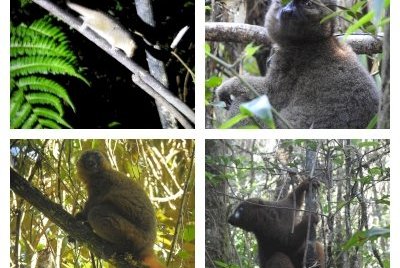
The Rainforests of the Atsinanana are the quintessential Malagasy WHS, as they comprise the last remaining patches of rainforest in Madagascar and are home to the iconic lemurs (of which 108 species have been discovered). Like the other reviewers before me, I choose to visit Ranomafana NP out of the 13 WH locations, as it is the easiest to reach. After 2 days of driving from the capital via Antsirabe along bare red soil and agricultural terraces, suddenly there they were: forests! Even in the dry season, it often rains here at night. More water is present at the river with a large waterfall next to the access road.
I stayed in Ranomafana village for one night; this way you can do the night walk after arrival and visit the diurnal creatures the next morning. You can allocate more time when you’re interested in a specialized subject like birds – the park has three sections, of which the main one holds most lemurs and the other two have their own qualities.
The night walk nowadays is executed along the road parallel to the park entrance - it is forbidden to enter the park borders after dark due to people getting lost / poaching (I heard both stories). I went with a local guide, for whom this side job was a welcome addition to his income as a banana farmer. He had sharp eyes, especially for chameleons, which became the stars of the walk. We saw many species, some …
Keep reading 0 comments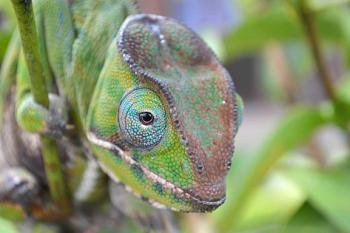
In August 2016, I decided to stop in Madagascar while traveling from Seychelles to Mayotte so that I could visit one of the national parks in the Rainforests of the Atsinanana WHS, which was inscribed in 2007, two years after my first visit to Madagascar. I began my trip in Antananarivo, where I stayed at Palissandre Hotel (http://www.hotel-restaurant-palissandre.com/), which overlooks Analakely Market, the city's largest. The only WHS national park that is within driving distance of Antananarivo is Ranomafana National Park, around nine hours from the capital. On the way, I visited Antsirabe, the country's third largest city, which still has several buildings from French colonial rule, including Hôtel des Thermes (1922) and the railway station (1923). From Antsirabe, it was around six hours to Ranomafana National Park, one of the national parks in the Rainforests of the Atsinanana WHS. During a very muddy morning hike, I saw several lemurs, including Milne-Edwards' sifaka, red-fronted brown lemur, greater bamboo lemur (which was thought extinct until rediscovered in 1986), eastern lesser bamboo lemur and golden bamboo lemur (which was discovered in 1986). During an evening hike, I saw several chameleons, including two-banded chameleon (♂ and ♀ (photo)), O'Shaugnessy's chameleon (♂ and ♀), short-nosed chameleon and side-striped chameleon, and brown mouse lemur.
Keep reading 0 comments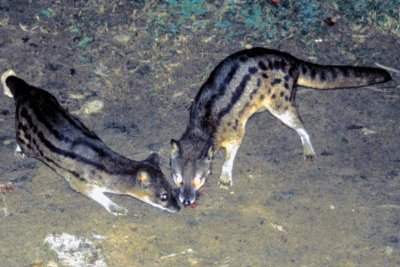
Madagascan forests provide a wonderful opportunity to see creatures you can see no where else in the world. Not just Lemurs but also other endemics such as the nocturnal “Fossa” or Malagasy Civet (photo). Amazingly, these animals are not so difficult to see!
But I was very concerned when I saw that this inscription consisted only of a number of widely dispersed “representative” areas. For us “WHS Collectors” this approach for defining WHS can lead to problems as to whether one has actually been into the inscribed site even if one has visited the whole area quite comprehensively. In 2000 we had a very successful visit to Madagscar in terms of seeing its endemics. One of our best memories was of wonderful views of the Indri Lemur in the reserve of Perinet (now called Analamazaotra Special Reserve or Andasibe). This is situated within the Atsinanana forest area which runs (or at least used to before Mankind destroyed much of it) along the eastern side of Madagascar. It is a “Special Reserve” adjacent to the Mantadia National Park which was part of the areas nominated in 2007. This reserve is without doubt one of the highlights of a visit to Madagsacar and will be visited by most tourists. You might think that all this would ensure that it would be included! If so you do not understand the ways of UNESCO and its evaluating agent IUCN!!!
IUCN was concerned that the nominated area might not actually be the “best …
Keep reading 0 comments
